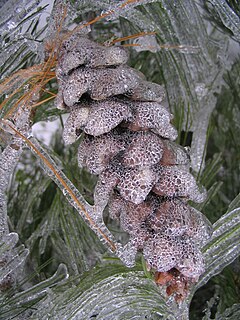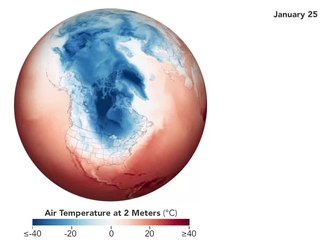Related Research Articles
A winter storm is an event in which varieties of precipitation are formed that only occur at low temperatures, such as snow or sleet, or a rainstorm where ground temperatures are low enough to allow ice to form. In temperate continental climates, these storms are not necessarily restricted to the winter season, but may occur in the late autumn and early spring as well. Very rarely, they may form in summer, though it would have to be an abnormally cold summer, such as the summer of 1816 in the Northeastern United States.

The Blizzard of 1996 was a severe nor'easter that paralyzed the United States East Coast with up to 4 feet (1.2 m) of wind-driven snow from January 6 to January 8, 1996. This storm was a classic example of a nor'easter, but the storm would not have been as historically significant without the presence of the arctic high pressure system located to the north of New York. It was followed by another storm, an Alberta Clipper, on January 12, then unusually warm weather and torrential rain which caused rapid melting and river flooding. Along with the March Superstorm of 1993, it is one of only two snowstorms to receive the top rating of 5, or "Extreme", on the Northeast Snowfall Impact Scale (NESIS).

A historic snowstorm struck the Ohio Valley of the United States, as well as Ontario in Canada, on December 22 and December 23 and is not the same storm that led to snow in Texas on Christmas Eve. It lasted roughly 30 hours, and brought snowfall amounts up to 29 inches (74 cm) to portions of the Midwestern United States. Damages from the storm totaled US$900 million (2004 dollars). A total of 18 died during the storm, one from Canada, mainly due to car accidents.
The Early Winter 2006 North American storm complex was a severe winter storm that occurred on November 26, 2006, and continued into December 1. It affected much of North America in some form, producing all kinds of severe weather including a major ice storm, blizzard conditions, high winds, extreme cold, a serial derecho and some tornadoes.
The Early December 2007 North American winter storm was a major winter storm which affected the majority of the United States and portions of southern Canada from November 29 to December 5, hitting the Intermountain West and Midwestern United States, the Great Lakes region and the Northeast. The storm brought significant snows to portions of the Upper Midwest, Great Plains and Great Lakes regions of the United States and Canada on December 1 with a major winter storm for Quebec, Ontario and parts of the Northeast region on December 2 and 3 as well as the Canadian Maritimes on December 4 and 5. The system was also responsible for a major ice storm across the Midwestern states which caused disruptions to several major cities including Des Moines, Chicago, Detroit, Milwaukee and Toronto. The storm was blamed for at least 16 deaths across nine US states and one Canadian province. 10 traffic deaths had been reported, as of 2 December 2007.

The North American blizzard of 2008 was a winter storm that struck most of southern and eastern North America from March 6 to March 10, 2008. The storm was most notable for a major winter storm event from Arkansas to Quebec. It also produced severe weather across the east coast of the United States with heavy rain, damaging winds and tornadoes, causing locally significant damage. The hardest hit areas by the wintry weather were from the Ohio Valley to southern Quebec where up to a half a meter of snow fell locally including the major cities of Columbus, Ohio, Cleveland, Ohio, and Ottawa, Ontario. For many areas across portions of the central United States, Ontario and Quebec, it was the worst winter storm in the past several years. The blizzard and its aftermath caused at least 17 deaths across four US states and three Canadian provinces, while hundreds others were injured mostly in weather-related accidents and tornadoes.
The December 2008 North American snowstorms were a series of snowstorms that struck across Canada and the US. The snowstorms caused snow to fall across Canada and many parts of the United States, and broke records for the amount of snow accumulated in many cities on Christmas Day.

The winter of 2009–2010 in Europe was unusually cold. Globally, unusual weather patterns brought cold, moist air from the north. Weather systems were undergoing cyclogenesis from North American storms moving across the Atlantic Ocean to the west, and saw many parts of Europe experiencing heavy snowfall and record-low temperatures. This led to a number of deaths, widespread transport disruption, power failures and postponed sporting events.

The December 2009 North American blizzard was a powerful nor'easter that formed over the Gulf of Mexico in December 2009, and became a major snowstorm that affected the East Coast of the United States and Canadian Atlantic provinces. The snowstorm brought record-breaking December snowfall totals to Washington, D.C., Baltimore, and Philadelphia.

The December 2000 nor'easter was a significant winter storm that impacted the Mid-Atlantic and New England regions of the United States around the end of the month. It began as an Alberta clipper that moved southeastward through the central United States and weakened over the Ohio Valley. However, it redeveloped off the coast of North Carolina and moved northward as it intensified. It moved into central Long Island and eventually tracked northward into New England. The storm dropped heavy precipitation throughout the Northeast, especially in northern New Jersey and eastern New York, where snowfall often exceeded 2 ft (0.61 m). Even so, as it struck on a weekend, its effects were generally minor and mostly limited to travel delays, traffic accidents, and business closures.

The winter of 2009–10 in the United Kingdom was a meteorological event that started on 16 December 2009, as part of the severe winter weather in Europe. January 2010 was provisionally the coldest January since 1987 across the country. A persistent pattern of cold northerly and easterly winds brought cold, moist air to the United Kingdom with many snow showers, fronts and polar lows bringing snowy weather with it.
The East Asian snowstorms of 2009–2010 were heavy winter storms, including blizzards, ice storms, and other winter events, that affected East Asia from 8 May 2009 to 28 February 2010. The areas affected included Mongolia, China, Nepal, the Korean Peninsula, Japan, Kuril Islands, Sea of Okhotsk, Primorsky, and Sakhalin Island.
Global storm activity of 2009 profiles the major worldwide storms, including blizzards, ice storms, and other winter events, from January 1, 2009 to December 31, 2009. Wintery storms are events in which the dominant varieties of precipitation are forms that only occur at cold temperatures, such as snow or sleet, or a rainstorm where ground temperatures are cold enough to allow ice to form. It may be marked by strong wind, thunder and lightning, heavy precipitation, such as ice, or wind transporting some substance through the atmosphere. Summer storms including flooding, severe thunderstorms and extratropical cyclones are also included in this list to a certain extent.

Global storm activity of 2008 profiles the major worldwide storms, including blizzards, ice storms, and other winter events, from January 1, 2008 to December 31, 2008. A winter storm is an event in which the dominant varieties of precipitation are forms that only occur at cold temperatures, such as snow or sleet, or a rainstorm where ground temperatures are cold enough to allow ice to form. It may be marked by strong wind, thunder and lightning, heavy precipitation, such as ice, or wind transporting some substance through the atmosphere. Major dust storms, Hurricanes, cyclones, tornados, gales, flooding and rainstorms are also caused by such phenomena to a lesser or greater existent.
Global storm activity of 2007 profiles the major worldwide storms, including blizzards, ice storms, and other winter events, from January 1, 2007, to December 31, 2007. Winter storms are events in which the dominant varieties of precipitation are forms that only occur at cold temperatures, such as snow or sleet, or a rainstorm where ground temperatures are cold enough to allow ice to form. It may be marked by strong wind, thunder and lightning, heavy precipitation, such as ice, or wind transporting some substance through the atmosphere. Other major non winter events such as large dust storms, Hurricanes, cyclones, tornados, gales, flooding and rainstorms are also caused by such phenomena to a lesser or greater existent.

The early 2012 European cold wave was a deadly cold wave that started on January 27, 2012, and brought snow and freezing temperatures to much of the European continent. There were more than 824 reported deaths in both Europe and North Africa. Particularly low temperatures hit several Eastern and Northern European countries, reaching as low as −42.7 °C (−44.9 °F) in Finland. The heaviest snow was recorded in the Balkan region. The cold weather was a result of an extensive area of very high pressure located in over the north east of the continent in northern Russia, which circulated cold air from the east.

The January 31 – February 2, 2015 North American blizzard was a major winter storm that plowed through the majority of the United States, dumping as much as 2 feet (24 in) of new snowfall across a path from Iowa to New England, as well as blizzard conditions in early February 2015. It came less than a week after another crippling blizzard which impacted the Northeast with 2–3 feet of snow. It was the first of many intense winter storms to occur in the nation during the month of February, partly in due to an ongoing cold wave that was beginning to take shape shortly after the storm subsided.
The March 2013 United Kingdom winter storm was an exceptional weather event that took place in the United Kingdom and Ireland on the night of 22–23 March 2013. Described as 'the worst snowfall for 30 years', the event brought chaos to many parts of Northern England, Northern Wales, Northern Ireland and Scotland. The worst places affected were North West England, North East Wales and Northern Ireland. Also accompanying the snow were very strong winds and very cold weather. At least two deaths were reported.

The 2018–19 North American winter is winter in North America as it is occurring across the continent from late 2018 through early 2019. So far, notable events have included snow in the Southeast in December, a strong cold wave and several major winter storms in the Midwest, Northeast and much of Canada late January and early February, record snowstorms in the Southwest late February, two nor'easters that affected the east coast early March, deadly tornado outbreaks in the Southeast, collapsing buildings in Quebec, a historic mid-April blizzard in the Midwest, but the most notable event all season was a record-breaking bomb cyclone that affected much of North America mid March. Unlike previous winters, a developing El Niño was expected to influence weather patterns across North America.
The January 1995 United Kingdom Blizzard was a period of extremely heavy snowfall that effected Northern England from the 25th-26th of January 1995. The snow hit the major cities during the rush hour, earlier than expected, and brought chaos to the cities of Sheffield and Leeds, leaving thousands stranded overnight. The city of Leeds received over 45 cm (18 in) in just the first 3 hours of the storm.
References
- ↑ Floors, Rogier. "Reanalysis archives". www.wetterzentrale.de.
- ↑ Floors, Rogier. "Reanalysis archives". www.wetterzentrale.de.
- ↑ Floors, Rogier. "Reanalysis archives". www.wetterzentrale.de.
- 1 2 3 4 5 "Late-Winter Snowstorm Batters Northwest Europe".
- 1 2 3 Grieser, Justin (12 March 2013). "Heavy snow halts travel in northwestern Europe".
- ↑ "Big snowstorm wreaks travel havoc in Europe".